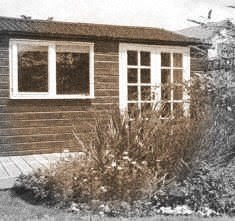HEY, WHERE HAS THE FLOOR GONE
Yes. A big mistake that many people make. Lack Of ForethoughtAs a designer, when facing a new project I find that it is always easier to START at the END. Now that may not make a lot of sense to you all, but if I have designed something, and it has been manufactured, and then those who ordered it cannot use it properly then there are going to be some very unhappy people around.
Grouping What We Want In Our Shed
Now, if we relate back to our earlier article on Who will Access Our Shed, we categorised our users. This does help us in our prospective contents list. Recapping, we have: The Kids: Our Wife, Husband or Partner: Mum, Dad, Relatives: Neighbours and other Visitors:
Let's start with The Kids.
If we have children, they do have a tendency to have toys, games, paddling pools, footballs, hockey sticks and the like. If we allow them to keep them in our shed, do we also want them to be able to get at them themselves. If the answer is yes, then it is no good putting little Jimmies' football at the back behind those dangerous sharp or toxic objects, or up high where he cannot reach. OK you say, We put it low and at the front.
GREAT.
Wait a moment. Did we say dangerous sharp or toxic objects. Mmm! but if we put those at the back but low, then little Jimmy may still be able to get them and hurt himself.
I know, let's put them up high.
FANTASTIC.
You have engaged the brain and found a solution. However you have now hit on a design problem.
Shed MATERIAL.
Many sheds are made of Galvanised material. They are quite sturdy, relatively easy to assemble and are cheaper but have a tendency to have thin walls. The first time you think that you will put a shelf up, you will find that a straight screw in the supporting brackets will strip the hole you have drilled for it, and become loose. The shelf will not stay up. Aha you say. No problem, I will put in an expanding plug which will open up in the original hole, take the screw easily, and give strength to the supporting brackets. So you mark out the height of the shelf. Place the markings for the screw holes on the shed wall (watch for ribbed/ channelled panels as you have to allow for the depth otherwise you brackets will not stick out enough.)
Right.
Shed position marked
Hole positions marked
Holed drilled.
Expanding plugs installed
Support brackets screwed on.
Shelf attached.
Hey presto. One shelf installed.
Place dangerous items on shelf.
Big pat on the back time.
So you have done it. You have installed the first shelf, so you go outside and lean on the shed wall with a smug look on your face.
"Ouch" You have now got a deep bleeding hole in your hand because there is one inch of each screw sticking out through the thin shed wall and you have just leaned against it.
So to put in shelving if you are not having a thick walled wooden shed then try placing a board on which the shelf can be attached on the inner wall, and screw/ bolt that to the shed wall from the outside where only screw/ bolt heads will be seen.
Next. Our Wife, Husband or Partner:
Do you want your beauties delicate hands and varnished fingernails being ripped to shreds by your saws as they try to get to the washing basket or clothes prop. No you do not, so think on the overall layout for easy access.
Are there items that we need to keep away from prying eyes (I mean we could be talking birthday present) If the answer is yes then we are now talking cupboard, toolbox, bookcase or even old wardrobe.
So, we have put in some type of storage unit listed above. It may require a lock, it may not. We have stored our bits and pieces.
In 4 weeks time, we open our cupboard, wardrobe or similar, and guess what. We find Mould and or damp. What we have done is placed our shed on the grass, Mud, sand or even concrete, but it does NOT have its own floor. Believe me, if you are serious about safety of stored items, then get a floor panel, separate flooring blocks/ slabs or even a shed with a built in floor. It will save a lot of grief later
.
This should keep you thinking so.
Bye for now.
Robin







